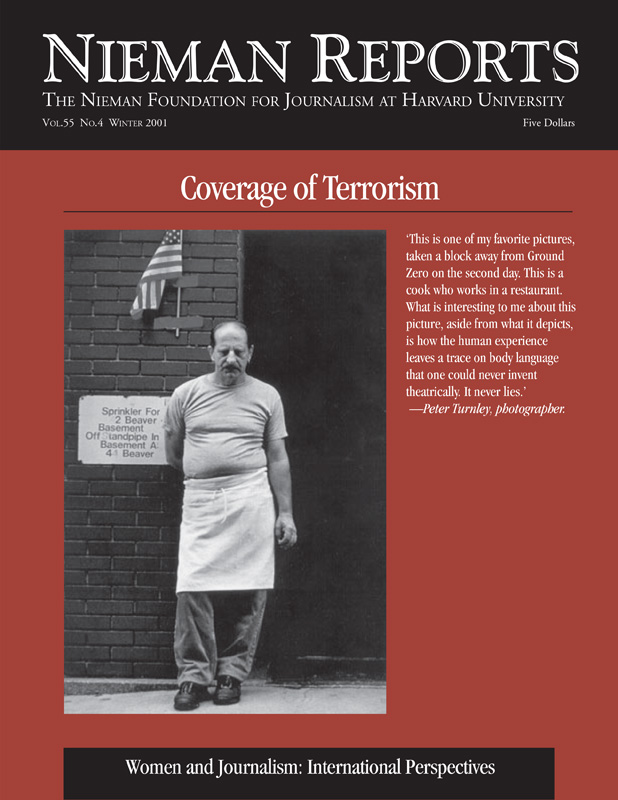
Wherever one looks in the world, women still have relatively little decision-making power either inside the media organizations themselves, or in the political and economic institutions with which these organizations must interface. This is one of the reasons why female journalists—even when they are a majority within the profession—remain highly vulnerable…. It can be argued that survival and success in journalism—at least in the market economies of Western Europe and North America—are dictated by the logic of commerce, to which male journalists are equally subject. Of course, there is an element of truth in this. But particularly when it comes to the most senior editorial jobs another—perhaps parallel, perhaps predominant—logic seems to operate. As Canadian journalist Huguette Roberge put it a decade ago: “One woman at a time…. One at a time. We barely manage to fill the shoes left by one another.” In the years since then, the situation has barely changed. It is as if one woman at the top is as much as the system can absorb without being thrown into a paroxysm of professional anguish about the potential effects—on status, salaries, self-esteem—of “feminization.”
In relation to the upper echelons of journalism, the notion that feminization could be imminent is risible. Even in the United States, figures produced by the National Federation of Press Women (1993) show that women have been increasing their share of management posts by only one percent per year since 1977. If that rate continues, it will be another 30 years before there is gender balance in top newspaper jobs in the United States.
Of course, it cannot be assumed that women’s existing rates of entry to any hierarchical level will continue…. But what of the women who entered the profession in the 1970’s and 1980’s? How have they fared in the decades since? The studies analyzed by professor David Weaver lead him to the overall conclusion that those women who are in American journalism have made “significant gains in managerial responsibility…and in amount of editorial control” over the past two decades. Nevertheless, given that since 1977 women have outnumbered men in college and university journalism courses in the United States, why are women still a minority presence in American newsrooms—especially in senior editorial and decision-making positions?
The same question is relevant throughout the industrialized world. UNESCO data show that in most of these countries the predominance of female students in mass communication courses stretches back to at least 1980. It is true that in many cases the percentage of practicing female journalists has risen substantially over the past 20 years…. It is also undeniable that, in many parts of the world, women are now a significant on-screen and on-air presence in the broadcast media—as presenters, reporters and newscasters…. In her analysis of the rise of the woman reporter over the past century, journalist Anne Sebba argues that it is no coincidence that a high proportion of the women journalists who covered the Gulf War in 1991 worked for television: “They know that what the major networks want is a frontline account from a (preferably pretty) woman in a flak jacket.”
Yet it is debatable whether this actually constitutes a “feminization” of journalism, in the sense of a take-over of the profession by women. Indeed women’s increased presence on the screen almost certainly contributes to a gulf between perceptions and reality. In most European countries, women are a clear minority of working journalists in radio and television. The exceptions are confined to countries formerly within the orbit of the Soviet Union, where the profession had an altogether different status from that in Western Europe. It is quite conceivable that, as the media systems of these countries move from a state-financed to a commercially financed basis, the proportion of women employed as journalists will fall—as has already been documented in the case of the former German Democratic Republic.
Moreover, when it comes to senior editorial and management jobs, women are consistently under-represented. In general, this pattern seems to hold even in the new commercial broadcasting companies—a finding that confounds the view that market-driven systems and audience goals will result in an increase of women’s power at the top…. Why do so few women reach the top?
By far the most common obstacle to career development reported by women journalists is the problem of male attitudes. One of the most important implications of the male dominance within media organizations is that women are judged by male standards and performance criteria. Often this means a constant effort to be taken seriously—a point made in a recent study of French journalists: “It’s really not easy to be taken seriously…. To begin with they treat you as a bit of a joke…. To show that you’re serious, you have to try twice as hard if you’re a woman.” The hazards of not being taken seriously include the risk of sexual harassment—a problem mentioned by women surveyed in countries as different as Finland and Spain. Thus while their male colleagues use time after work to develop the “old boys’ network,” some women may limit their after-work contacts because they prefer to avoid “risky” situations.
Perceptions of editorial management as a tough and virile domain, where decisions are made by men in smoke-filled rooms, are enough to stop some women from trying to become part of a world they regard as alien. More importantly, they affect the promotion prospects of many women who do aspire to senior positions. In the words of a Danish journalist disappointed in her attempt to obtain a management post in the early 1990’s: “All my colleagues recommended me, but the management said… I wasn’t ‘robust’ enough. The management don’t like women in managerial jobs. Only one has succeeded so far, but it took her more than 25 years.” The “one at a time” mentality vis-à-vis women in senior editorial management precludes the possibility of women building up the kind of power base necessary for real change—either in terms of journalistic output or in the way the institutions of journalism are organized.
One of the major ways in which stereotyped attitudes impinge on women journalists is in the assignment of work. In a 1992 survey covering 10 countries in Europe, North America, Asia and Africa, writer Kate Holman found that 56 percent of responding journalists (male and female) believed that women are still directed towards topics which traditionally have had less status (human interest, social affairs, and culture), rather than being steered towards the “high-status” topics such as business, economics or foreign news. Although this rigid division of labor has started to break down in certain countries, the general tendency to streamline women and men into different departments and subject areas undoubtedly has an impact on salary and on promotion prospects.
There is overwhelming evidence of a significant salary gap between female and male journalists…. It seems likely that the earnings gap is related to the kinds of assignment given to women and men—the specific tasks they do and the valuation attached to these through additional payments and merit awards.
The gendered division of work assignments reduces more than women’s income. It also reduces their chances of promotion…. A journalist writing about “hard politics” is supported and regarded as good promotion material. Someone writing about “human” and “everyday” issues is seen as unambitious (because of apparent disinterest in the top priorities of the organization), and tends to remain a rank-and-file reporter. The subtlety and circularity of this process, which both reflects and constructs power relations between women and men in the profession, is aptly described by Professor Eric Neveu with respect to French journalism: “the female condition is a constraint on access to responsibilities in journalism…this distance from responsibilities and important columns increases the probability of meeting less famous people, thus having to settle for more anonymous, soft news reporting…which in a nutshell produces a journalism typified as ‘feminine’…. If women write what they write, it is not always the expression of a feminine sensibility…but also the fact that in many situations they cannot write anything else, according to the structures of power within the professional hierarchy.”
In her study of women’s impact on the British press (1997) journalism lecturer Linda Christmas concludes that political writing is one of two “stubbornly male enclaves.” The other is leader writing (editorials). Again, the rules of the game mean that women are not seen as—and usually do not see themselves as—suited to this form of journalism. One of the few female leader writers in Britain (for The Times) ascribes the small number of women to “a stereotyped notion of how women’s brains work…. Men are thought to be more convergent, more dispassionate, more analytical than women are. And women have been assumed to be better at writing the empathetic, people-orientated stories,” according to Christmas. This general stereotype feeds into gender-based editorial appraisals, as Christmas writes: “There are some editors who instinctively, without questioning it, give less weight to women’s views. Also, some editors may think that women are more muddled thinkers and therefore it is not just that they think their views are unimportant, but that their views won’t be expressed quite so coherently as men’s views.” The notion that coherence equates with the bold affirmation of a particular viewpoint is, again, something with which many women feel uncomfortable. According to another senior woman interviewed by Christmas: “My dream is to be able to write ‘on the one hand’ and ‘on the other hand,’ and ‘having thought about it carefully, this is the conclusion I come to.’ But I know you can’t write columns like that. Or leaders. You need to have very, very firm opinions and a belief in your own opinions.”
The male-defined rules of the game which determine journalistic culture—the customs and practices which prevail within the profession—must therefore be understood not simply in terms of working conditions, definitions of newsworthiness, values and priorities. In a more fundamental sense these rules permeate the very essence of what journalism “is,” or is believed to be, by the majority of its practitioners. Of course, they are not completely static. It can be argued that the audience goal of journalism implies that the rules must—in some respects—be subject to redefinition if markets are to be fully exploited. But given the framework of power relations in journalism, it cannot be assumed that such redefinitions will work to women’s long-term advantage. If audience behavior causes a shift in the hierarchy of genres, or in professional beliefs about what constitutes “good” journalism, it is inconceivable that male journalists will ignore the new ground opened up by such a change.
The belief that the gender balance in journalism—particularly in its higher echelons—will shift “in time” as more women graduates enter the profession is remarkably persistent. UNESCO’s first World Communication Report (1989), noting that the proportion of female journalism students is very much higher then the percentage of female working journalists in almost every country, concludes that “other things being equal, women’s share of jobs in journalism will gradually increase in the coming years.” But, of course, other things are not equal—even at the starting post. Studies from various countries show that male journalism graduates are more successful than females in finding jobs in the profession. After recruitment men advance more quickly than women….
To bring about shifts in the organizational culture and in the attitudes of key staff, some media companies have adopted policies and action programs. These are more often found in the broadcast media than in the press, and more often in publicly funded than in the commercially financed sector. In that sense, market trends do not present a promising scenario for women…. The pursuit of equal opportunities does not easily coincide with the pursuit of maximum financial gain.
But even when they work, equal opportunities policies seem to drag change along behind them—at what often seems an excruciatingly slow place—rather than pushing media institutions forcefully towards transformation. In the sphere of gender relations, the most recalcitant obstacle to transformation is that of attitudes. Andy Allan, the chief executive of Carlton UK Television, has expressed this succinctly: “From the cradle, we have people brought up with certain expectancies of what they are likely to achieve and what they can achieve. If we don’t see this as a human problem, rather than a female problem, we won’t crack it. No single initiative within a media organization will take this very far…. The major problem is nothing but simple prejudice, and we should reply to any technician who complains: ‘Don’t give me any more of that rubbish about women not being able to handle cameras.’” Or, he might have said, that rubbish about women not being “robust” enough to handle the job of chief executive.
Margaret Gallagher is a freelance researcher and writer specializing in gender and media. Her work includes assignments for the United Nations Statistics Division, UNIFEM, UNESCO, the International Labour Office, the Council of Europe, The European Commission, and the European Audiovisual Observatory. She has many publications in the field of gender portrayal and employment in the media, including “An Unfinished Story: Gender Patterns in Media Employment” (Paris, UNESCO Publishing, 1995) and “Gender Setting: New Agendas for Media Monitoring and Advocacy (London, Zed Books 2001).


